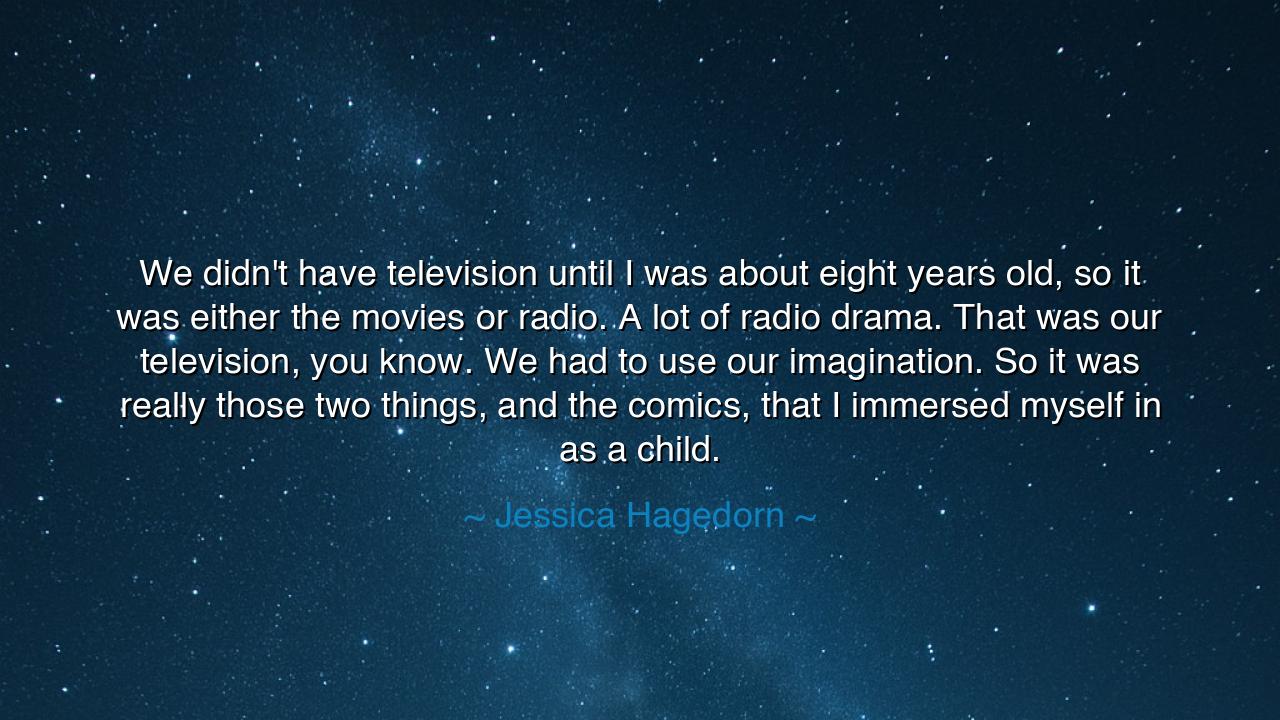
We didn't have television until I was about eight years old, so
We didn't have television until I was about eight years old, so it was either the movies or radio. A lot of radio drama. That was our television, you know. We had to use our imagination. So it was really those two things, and the comics, that I immersed myself in as a child.






"We didn't have television until I was about eight years old, so it was either the movies or radio. A lot of radio drama. That was our television, you know. We had to use our imagination. So it was really those two things, and the comics, that I immersed myself in as a child." These words, spoken by Jessica Hagedorn, reflect the power of imagination in shaping one’s world. In an era when television was not yet a part of everyday life, Hagedorn's childhood was steeped in the stories and dramas of the radio and the visual imagery of the comics. These forms of entertainment—where images were painted not with the brush but with words and sounds—allowed the mind to wander and create, painting vivid worlds in the mind’s eye. It is a reminder that imagination does not need the aid of modern technology to flourish; rather, it thrives in the spaces where the mind is free to dream.
In the ancient world, storytelling was a revered art, and the power of the spoken word was understood to be a bridge between the tangible world and the world of ideas and dreams. The Greeks—who, like Hagedorn, lacked the modern conveniences of screens—understood the power of oral tradition. The tales of Homer’s Iliad and Odyssey were told aloud, passed from one generation to the next. These stories did not rely on visual representations, but rather on the imagination of the listener, who would envision the gods, the battles, and the landscapes as they listened to the voice of the storyteller. Similarly, the bards of ancient cultures would travel from village to village, filling the minds of their audiences with images of heroes and legends that existed only in the realm of the mind.
In this context, Hagedorn’s reflection on radio drama becomes a modern parallel to this ancient tradition. Before the rise of visual media, the radio was an instrument that stirred the imagination, just as the voices of the bards had done centuries earlier. Through the sounds of dialogue, music, and effects, the radio allowed listeners to paint their own pictures of what the drama looked like. Sound became a tool for transporting the mind to different places, to different times, to different lives. This reliance on imagination in the absence of visual stimuli is something we must not forget in an age where media is saturated with images and instant gratification.
Consider the ancient oral poets who would craft entire epics from the depths of their minds. Virgil, in his Aeneid, did not merely tell a story of gods and mortals; he weaved an entire world that lived in the minds of his listeners. The listener’s imagination brought Virgil’s words to life in ways that were unique to each person. Even in ancient Rome, where grand visual spectacles existed, the true magic lay in the ability of the words to spark imagery in the minds of the people. Hagedorn’s childhood experience mirrors this timeless process—where the mind must create its own images based on the words it hears, rather than relying on pre-made visuals.
In the same way, comics—as mentioned by Hagedorn—serve as a modern counterpart to this ancient practice of storytelling. Though comics have images, they still demand that the reader participate in the creation of the narrative, filling in the spaces between the panels with their own thoughts and emotions. The very essence of the comic lies in the balance between visual art and imagination. The reader’s mind must bring the characters and the story to life, expanding upon the images to create an experience that is unique to each individual. In this way, comics, like radio drama, become a collaborative act of storytelling between the creator and the audience.
The lesson here is one of active engagement with the world around us, especially in the realm of creativity and storytelling. Just as Hagedorn immersed herself in these forms of media—where she was called to use her imagination—we too must cultivate our ability to create and imagine in our own lives. The world often gives us ready-made answers, ready-made images, and ready-made experiences, but the true joy of life lies in those moments when we are forced to imagine for ourselves. Whether it is through books, art, or the stories we hear, we must always remember that creativity is not a passive act; it is an active, ongoing engagement with the world around us, one that requires energy, focus, and imagination.
Let us take this wisdom from Hagedorn’s experience and apply it to our own lives. In a world dominated by screens and endless distractions, let us carve out moments to engage our minds in the way that Hagedorn did—through imagination, stories, and experiences that encourage mental participation. Whether listening to a piece of music, reading a book, or simply reflecting on the world around us, we can reclaim the power of the mind to create, to imagine, and to dream. The greatest gift we can give ourselves is the ability to see beyond what is immediately before us and to use our minds to build new worlds, just as the ancient storytellers did and as Hagedorn did in her youth. The world of imagination is vast, and it is always within reach if we dare to engage with it fully.






AAdministratorAdministrator
Welcome, honored guests. Please leave a comment, we will respond soon